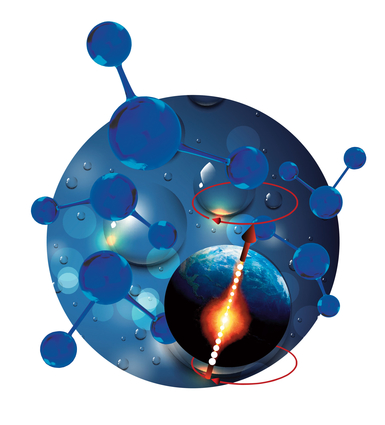Lawrence Livermore scientists measure rock in a hard place
 (Download Image)
(Download Image)
LLNL scientists have created a tool that allows scientists to probe temperatures of hydrothermal systems in the Earth's crust. Image courtesy of Greg Pautler/Graphic Design, Cambridge, Ontario, Canada.
Measuring the extreme pressures and temperatures of hydrothermal systems in the Earth's crust is no easy feat.
However, Lawrence Livermore National Laboratory scientists have made a new tool that allows them to probe pressures up to 20 kbar (20,000 Earth atmospheres of pressure).
The equation of state of the Earth's crust where water-rock interactions occur is believed to be 1,200 degrees Celsius and 60 kbars (60,000 atmospheres of pressure). Whereas earlier tools could only go up to 5 kbars (5,000 atmospheres), the new LLNL nuclear magnetic resonance (NMR) probe can measure four times more.
Aqueous geochemical reactions involving common crustal elements/compounds such as aluminum, silicates, magnesium, carbonates, sulfur and boron, have been examined experimentally using diamond-anvil cells coupled to Raman spectroscopy in an attempt to extract thermodynamic properties.
"The development of a new high-resolution spectroscopic technique would complement these measurements and allow for a better understanding of high-pressure aqueous chemistry," said LLNL's Stephen Harley, one of the authors of a paper appearing in an upcoming issue of the journal, Angewandte.
UC Davis postdoc Brent Pautler is lead author of the paper.
NMR spectroscopy has already emerged as a powerful analytical technique to monitor chemical processes within the environment. The advancements in high-resolution, high-pressure probe design has allowed for the study of geochemical reaction dynamics and has enabled monitoring of the pressure dependencies of critical micelle concentrations, quantification of dissolved gases in solution to monitor catalytic reactions, as well as several biological studies probing protein folding, aggregation andstabilization of rare high-energy states.
"Despite the tremendous scientific advancement from these studies, the current NMR probe designs cannot fully accommodate both the high pressures and high-resolution molecular-level data needed to begin to evaluate the geochemical model," Harley said.
LLNL researchers collaborated with the University of California, Davis, Monash University, Johns Hopkins University and the Carnegie Institution of Washington.
Contact
 Anne M. Stark
Anne M. Stark
[email protected]
(925) 422-9799
Related Links
"A High-Pressure NMR Probe for Aqueous Geochemistry"Stephen Harley
Energetic Materials Center
Ready to respond to chemical weapons
A 1-ton device in a suitcase
Tags
Physical and Life SciencesFeatured Articles







